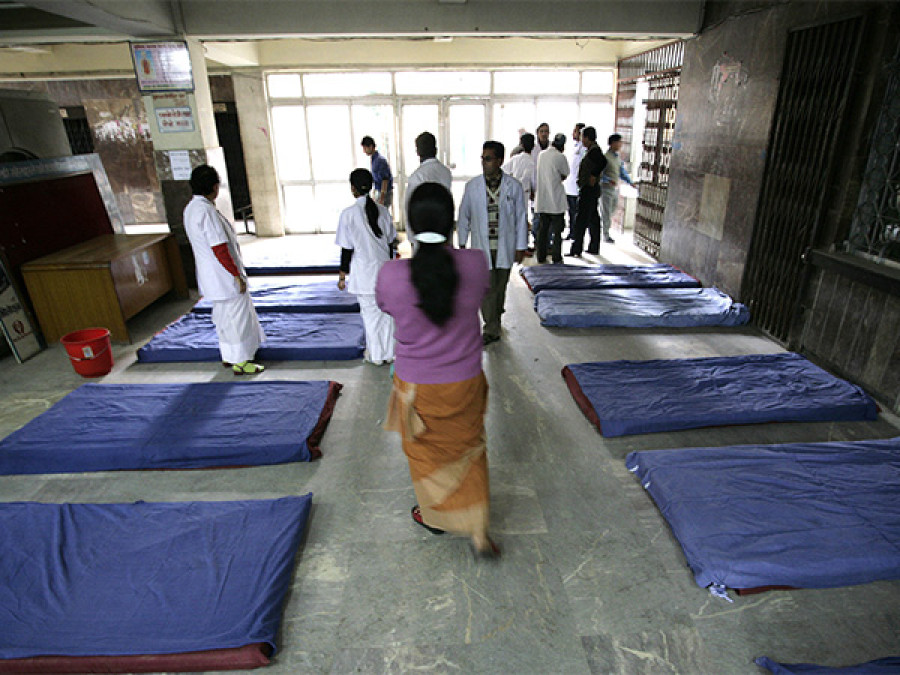Miscellaneous
Unsafe Schools, hospitals
For Ritu Poudel, a tenth-grader at Kankali Secondary School, Naikap, home is not as safe as school when it comes to earthquake.
Development Bureau
“We conduct drill every year where we are taught the ways to remain safe during earthquake,” said Poudel.
But not all schools and students can feel the same sense of safety as Poudel.
A survey carried out by the National Society for Earthquake Technology (NSET) in 2005 in 643 schools in Kathmandu Valley showed that over 66 percent of the schools were likely to collapse in an earthquake with intensity IX on the modified Mercalli Scale. A quake of such scale, and during school hours, could kill more than 29,000 students and teachers and injure around 43,000 in the Valley. Loss in terms of damaged buildings would amount to more than seven million dollars.
After the NSET report got published, the Department of Education (DoE), in collaboration with the NSET, began retrofitting many school buildings in the Valley. The programme was expanded outside the Valley as well; in 2013, the DoE decided to retrofit community school buildings in seven more districts. Jhappar Bishwokarma, construction unit chief at DoE, said four companies have been selected to carry out vulnerability assessment and detailed design and cost estimation for retrofitting in 350 schools in Jhapa, Morang, Dhanusha, Parsa, Rupendehi, Banke and Kailali districts.
The DoE started retrofitting public schools in the Valley from last year, after an earthquake measuring 6.8 on the Richter scale on September 18, 2011, damaged many school buildings in eastern Nepal.
According to Comprehensive School Safety of DoE, there are three components that could ensure that schools are safe. First, building safe physical facility, second is school disaster risk management where capacity has to be developed of students and teachers to cope with the deadly disaster. The last component is disaster risk management education where earthquake safety measures and preparedness are taught in school curriculum.
Besides school building, hospitals are also vulnerable to earthquake, as few of the hospital are retrofitted. Many hospitals that are established in residential building are at high risk, experts say.
Earlier, World Health Organization (WHO) and NSET had conducted two studies—Structural Assessment of Hospitals and Health Institutions of Kathmandu Valley and Non-Structural Vulnerability Assessment of Hospitals in Nepal—in 2001 and 2003. The results showed that around 80 percent of the hospitals that were assessed fell under the “unacceptable performance” category.
As many research and survey say that hospitals lie in peril, the Ministry of Health and Population (MoHP) has begun retrofitting some hospitals, including Patan Hospital, while assessments are still underway at Kanti Children’s Hospital, Bir Hospital, Prasuti Griha, Police Hospital, Birendra Army Hospital and Tribhuvan University Teaching Hospital. These hospitals have been selected for detailed design and cost estimation for retrofitting.
Dr Guna Raj Lohani, chief of curative division at MoHP, said the ministry, with the support of WHO and Department for International Development, began earthquake vulnerability survey of 60 hospitals across the country in 2012.
“The visual assessment of all of these hospitals have been completed, while 21 hospitals are slated to go through a seismic assessment in the second phase,” Dr Lohani said.
An advisory committee, formed by the MoHP, will pick 10 hospitals for retrofitting, the proposal for which will be discussed with various donors in a meeting likely to take place this year.
Dr Lohani said the MoHP’s ‘Directives on Establishment, Operation and Upgrading of Health Institute 2013’ have strictly barred the operation of any new hospitals that do not show their earthquake resistance structure. The already operating hospitals have also been instructed to ensure earthquake safety structures.




 5.27°C Kathmandu
5.27°C Kathmandu









